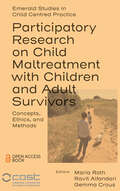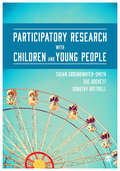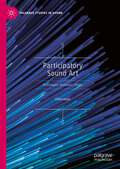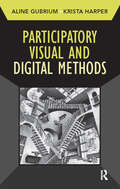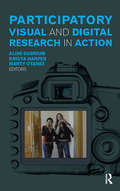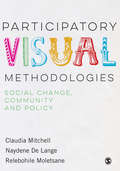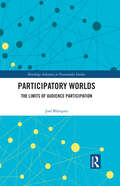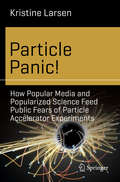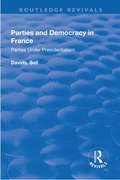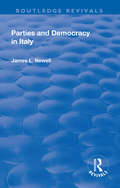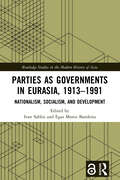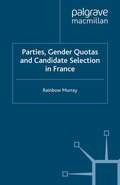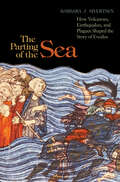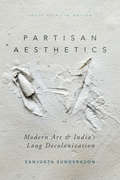- Table View
- List View
Participatory Research on Child Maltreatment with Children and Adult Survivors: Concepts, Ethics, and Methods (Emerald Studies in Child Centred Practice)
by MARIA ROTH, RAVIT ALFANDARI, GEMMA CROUSThe ebook edition of this title is Open Access and freely available to read online. Childhood should be free of violence, and victims of childhood maltreatment should be entitled to participate as expert informants in research about these experiences. Placing children and adult survivors at the heart of research efforts on child maltreatment is critical to effective response and prevention measures in fighting this form of violence. Embedded in the European context, Participatory Research on Child Maltreatment with Children and Adult Survivors presents a mosaic of contexts, theories, and methods relating to children’s and adult survivors’ participation in research about their adverse experiences. Contributors demonstrate how research can mobilize children and adult survivors to become agents in constructing and disseminating reliable, evidence-based knowledge about child maltreatment. Enriching ongoing debates about ethical concerns and challenges of participatory research in the field of child maltreatment, this contribution to Emerald Studies in Child Centred Practice highlights the advantages that participation as a human right and as a valued endeavour of scientific knowledge accumulation can bring to communities of researchers and helping professionals. The authors of this book are members of a designated working group of the pan-European network on Multisectoral Responses to Child Abuse and Neglect in Europe (Euro-CAN), supported by the European Cooperation on Science Technology (COST Action 19106), that promote children’s and child abuse survivors’ participation in research on violence.
Participatory Research on Child Maltreatment with Children and Adult Survivors: Concepts, Ethics, and Methods (Emerald Studies in Child Centred Practice)
by Maria Roth Ravit Alfandari Gemma CrousThe ebook edition of this title is Open Access and freely available to read online. Childhood should be free of violence, and victims of childhood maltreatment should be entitled to participate as expert informants in research about these experiences. Placing children and adult survivors at the heart of research efforts on child maltreatment is critical to effective response and prevention measures in fighting this form of violence. Embedded in the European context, Participatory Research on Child Maltreatment with Children and Adult Survivors presents a mosaic of contexts, theories, and methods relating to children’s and adult survivors’ participation in research about their adverse experiences. Contributors demonstrate how research can mobilize children and adult survivors to become agents in constructing and disseminating reliable, evidence-based knowledge about child maltreatment. Enriching ongoing debates about ethical concerns and challenges of participatory research in the field of child maltreatment, this contribution to Emerald Studies in Child Centred Practice highlights the advantages that participation as a human right and as a valued endeavour of scientific knowledge accumulation can bring to communities of researchers and helping professionals. The authors of this book are members of a designated working group of the pan-European network on Multisectoral Responses to Child Abuse and Neglect in Europe (Euro-CAN), supported by the European Cooperation on Science Technology (COST Action 19106), that promote children’s and child abuse survivors’ participation in research on violence.
Participatory Research with Children and Young People
by Dorothy Bottrell Sue Dockett Susan Groundwater-SmithThis book sets out a clear framework for conducting participatory research with children and young people within a discussion of the rights of the child. Through extensive case studies and a close review of contemporary literature, in relation to early childhood through to late adolescence, the book serves as a critical guide to issues in participative research for students and researchers. The book includes chapters on: Designing your research project Ethical considerations Innovative methods Publication and dissemination.
Participatory Research with Children and Young People (PDF)
by Dorothy Bottrell Sue Dockett Susan Groundwater-SmithThis book sets out a clear framework for conducting participatory research with children and young people within a discussion of the rights of the child. Through extensive case studies and a close review of contemporary literature, in relation to early childhood through to late adolescence, the book serves as a critical guide to issues in participative research for students and researchers. The book includes chapters on: Designing your research project Ethical considerations Innovative methods Publication and dissemination.
Participatory Sound Art: Technologies, Aesthetics, Politics (Palgrave Studies in Sound)
by Vadim KeylinThis book addresses a major gap in sound art scholarship: the role of audience participation. It offers a survey of participatory sound art from its origins in the historical avant-gardes to the non-institutionalized forms of sonic creativity in contemporary digital culture. In doing so, it proposes an innovative theoretical framework for analysing such phenomena, rooted in Pragmatist aesthetics, affordance theory and postcritique. Combining artwork analyses with qualitative studies, it focuses on three principal aspects of participatory sound art: the ways the materialities of the artworks facilitate and structure the participatory processes; the interplay of the creative agencies of the artists and the participants; and the postcritical approach to sound art’s politics, unfolding through the participants’ affective gestures. In considering these multiple dimensions, this book contributes to the growing fields of sound studies and participation studies, as well as to curatorial practice regarding sound art and participatory art.
Participatory Visual and Digital Methods (Developing Qualitative Inquiry)
by Krista Harper Aline GubriumGubrium and Harper describe how visual and digital methodologies can contribute to a participatory, public-engaged ethnography. These methods can change the traditional relationship between academic researchers and the community, building one that is more accessible, inclusive, and visually appealing, and one that encourages community members to reflect and engage in issues in their own communities. The authors describe how to use photovoice, film and video, digital storytelling, GIS, digital archives and exhibits in participatory contexts, and include numerous case studies demonstrating their utility around the world.
Participatory Visual and Digital Methods (Developing Qualitative Inquiry #10)
by Krista Harper Aline GubriumGubrium and Harper describe how visual and digital methodologies can contribute to a participatory, public-engaged ethnography. These methods can change the traditional relationship between academic researchers and the community, building one that is more accessible, inclusive, and visually appealing, and one that encourages community members to reflect and engage in issues in their own communities. The authors describe how to use photovoice, film and video, digital storytelling, GIS, digital archives and exhibits in participatory contexts, and include numerous case studies demonstrating their utility around the world.
Participatory Visual and Digital Research in Action (Qualitative Essentials)
by Aline Gubrium Krista Harper Marty OtañezThis collection of original articles, a companion to the authors’ Participatory Visual and Digital Methods, illustrates how innovative visual and digital research techniques are being used in various field projects in health care, environmental policy, urban planning, education and youth development, and heritage management settings. These methodologies produce rich visual and narrative data guided by participant interests and priorities, key tools for collaborative work. The 16 chapters-include digital storytelling, PhotoVoice, community-based filmmaking, participatory mapping and GIS, and participatory digital archival research;-provide a portfolio of model research projects for researchers who wish to collaborate on community-based studies;-will appeal to an audience across social science, heritage, health, education, and social service fields.An open-access companion website will allow readers to view the research products presented in each contributor's chapter.
Participatory Visual and Digital Research in Action (Qualitative Essentials)
by Aline Gubrium Krista Harper Marty OtañezThis collection of original articles, a companion to the authors’ Participatory Visual and Digital Methods, illustrates how innovative visual and digital research techniques are being used in various field projects in health care, environmental policy, urban planning, education and youth development, and heritage management settings. These methodologies produce rich visual and narrative data guided by participant interests and priorities, key tools for collaborative work. The 16 chapters-include digital storytelling, PhotoVoice, community-based filmmaking, participatory mapping and GIS, and participatory digital archival research;-provide a portfolio of model research projects for researchers who wish to collaborate on community-based studies;-will appeal to an audience across social science, heritage, health, education, and social service fields.An open-access companion website will allow readers to view the research products presented in each contributor's chapter.
Participatory Visual Methodologies: Social Change, Community and Policy (PDF)
by Claudia Mitchell Naydene De Lange Relebohile MoletsaneThis book demonstrates how data from participatory visual methods can take people and communities beyond ideological engagement, initiating new conversations and changing perspectives, policy debates, and policy development. These methods include, for example, photo-voice, participatory video, drawing/mapping, and digital storytelling. Organised around a series of tools that have been used across health, education, environmental, and sociological research, Participatory Visual Methodologies illustrates how to maintain participant engagement in decision-making, navigate critical issues around ethics, track policies, and maximize the potential of longitudinal studies. Tools discussed include: Pedagogical screenings Digital dialogue devices Upcycling and ‘speaking back’ interventions Participant-led policy briefs An authoritative and accessible guide to how participatory visual methods and arts-based methods can influence social change, this book will help any postgraduate researcher looking to contribute to policy dialogue.
Participatory Visual Methodologies: Social Change, Community and Policy
by Relebohile Moletsane Naydene De Lange Claudia MitchellThis book demonstrates how data from participatory visual methods can take people and communities beyond ideological engagement, initiating new conversations and changing perspectives, policy debates, and policy development. These methods include, for example, photo-voice, participatory video, drawing/mapping, and digital storytelling. Organised around a series of tools that have been used across health, education, environmental, and sociological research, Participatory Visual Methodologies illustrates how to maintain participant engagement in decision-making, navigate critical issues around ethics, track policies, and maximize the potential of longitudinal studies. Tools discussed include: Pedagogical screenings Digital dialogue devices Upcycling and ‘speaking back’ interventions Participant-led policy briefs An authoritative and accessible guide to how participatory visual methods and arts-based methods can influence social change, this book will help any postgraduate researcher looking to contribute to policy dialogue.
Participatory Worlds: The limits of audience participation (ISSN)
by José BlázquezThis book is an in-depth analysis of participatory worlds, practices beyond the mainstream models of content production and IP management that allow audience members to contribute canonically to the expansion of storyworlds, blurring the line between the traditional roles of consumers and producers.Shifting discussions of participatory culture and cross-media production and consumption practices to more independent media contexts, the book explores the limits, borders and boundaries of participating in today’s digital media storyworlds. The text examines how audience participation works, identifying opportunities to make it a meaningful practice for audiences and an asset for IP owners, and discussing the challenges and barriers that the application of participatory culture brings along. The book defines what meaningful participation is by introducing the concept of ‘intervention’ and explains a range of factors impacting the way in which participatory worlds and relationships between producers, audiences and the world are shaped.This volume will be of great relevance to media practitioners, scholars and students interested in transmedia storytelling, fandom, literary studies and comparative literature, new media and digital culture, gaming and media studies.
Participatory Worlds: The limits of audience participation (ISSN)
by José BlázquezThis book is an in-depth analysis of participatory worlds, practices beyond the mainstream models of content production and IP management that allow audience members to contribute canonically to the expansion of storyworlds, blurring the line between the traditional roles of consumers and producers.Shifting discussions of participatory culture and cross-media production and consumption practices to more independent media contexts, the book explores the limits, borders and boundaries of participating in today’s digital media storyworlds. The text examines how audience participation works, identifying opportunities to make it a meaningful practice for audiences and an asset for IP owners, and discussing the challenges and barriers that the application of participatory culture brings along. The book defines what meaningful participation is by introducing the concept of ‘intervention’ and explains a range of factors impacting the way in which participatory worlds and relationships between producers, audiences and the world are shaped.This volume will be of great relevance to media practitioners, scholars and students interested in transmedia storytelling, fandom, literary studies and comparative literature, new media and digital culture, gaming and media studies.
Particle Panic!: How Popular Media and Popularized Science Feed Public Fears of Particle Accelerator Experiments (Science and Fiction)
by Kristine LarsenFrom novels and short stories to television and film, popular media has made a cottage industry of predicting the end of the world will be caused by particle accelerators. Rather than allay such fears, public pronouncements by particle scientists themselves often unwittingly fan the flames of hysteria. This book surveys media depictions of particle accelerator physics and the perceived dangers these experiments pose. In addition, it describes the role of scientists in propagating such fears and misconceptions, offering as a conclusion ways in which the scientific community could successfully allay such misplaced fears through more effective communication strategies. The book is aimed at the general reader interested in separating fact from fiction in the field of high-energy physics, at science educators and communicators, and, last but not least, at all scientists concerned about these issues. About the Author Kristine M Larsen holds a Ph.D. in Physics and is currently a professor at Central Connecticut State University, New Britain, CT, in the Geological Sciences Department. She has published a number of books, among them The Women Who Popularized Geology in the 19th Century (Springer, 2017), The Mythological Dimensions of Neil Gaiman (eds. Anthony Burdge, Jessica Burke, and Kristine Larsen. Kitsune Press, 2012. Recipient of the Gold Medal for Science Fiction/Fantasy in the 2012 Florida Publishing Association Awards), The Mythological Dimensions of Doctor Who (eds. Anthony Burdge, Jessica Burke, and Kristine Larsen. Kitsune Press, 2010), as well as Stephen Hawking: A Biography (Greenwood Press, 2005) and Cosmology 101 (Greenwood Press, (2007).
Parties and Democracy in France: Parties Under Presidentialism (Routledge Revivals)
by David S BellThis title was first published in 2000: The Presidency has been the principal political focus of the French Fifth Republic and the new component of French democracy. This book looks at how the Presidency has shaped political parties and party systems, as well as how they have interacted with the new institution. The Presidency has acted as a unifying force, bringing together coalitions of parties to provide a political basis for presidential power, but has also been a divisive factor. Parties draw on longstanding traditions of French political life and the Presidency can provoke destructive rivalry as well as constructive coalition-building. Presented here is a discussion of the contemporary French party system - its dynamics, successes and failures. Written in an accessible style, it is intended for students of French studies and political parties, as well as comparative politics.
Parties and Democracy in France: Parties Under Presidentialism (Routledge Revivals)
by David S BellThis title was first published in 2000: The Presidency has been the principal political focus of the French Fifth Republic and the new component of French democracy. This book looks at how the Presidency has shaped political parties and party systems, as well as how they have interacted with the new institution. The Presidency has acted as a unifying force, bringing together coalitions of parties to provide a political basis for presidential power, but has also been a divisive factor. Parties draw on longstanding traditions of French political life and the Presidency can provoke destructive rivalry as well as constructive coalition-building. Presented here is a discussion of the contemporary French party system - its dynamics, successes and failures. Written in an accessible style, it is intended for students of French studies and political parties, as well as comparative politics.
Parties and Democracy in Italy
by James L NewellThis title was first published in 2000: A guide to the changing place of political parties within the Italian political system, seeking to shed light on how the parties operate and their role in the country's politics. Starting from a recognition of the traditional centrality of parties in Italian political life, the book's main focus is on the consequences and causes of the transformation in the party system which began to unfold from 1989 onwards. Arguing that the latter has its roots in the specific choices made by the traditional parties as they attempted to adapt to change in their electoral environment, the book then proceeds to examine what effects the changing party system is having on such traditional, "party-driven" features of Italian politics such as "sottogoverno" and "lotizzazione" and on the functioning of such institutions as parliament and the executive. The book concludes by attempting to assess whether parties are still central to political and civil society or whether their role has diminished in importance.
Parties and Democracy in Italy
by James L NewellThis title was first published in 2000: A guide to the changing place of political parties within the Italian political system, seeking to shed light on how the parties operate and their role in the country's politics. Starting from a recognition of the traditional centrality of parties in Italian political life, the book's main focus is on the consequences and causes of the transformation in the party system which began to unfold from 1989 onwards. Arguing that the latter has its roots in the specific choices made by the traditional parties as they attempted to adapt to change in their electoral environment, the book then proceeds to examine what effects the changing party system is having on such traditional, "party-driven" features of Italian politics such as "sottogoverno" and "lotizzazione" and on the functioning of such institutions as parliament and the executive. The book concludes by attempting to assess whether parties are still central to political and civil society or whether their role has diminished in importance.
Parties as Governments in Eurasia, 1913–1991: Nationalism, Socialism, and Development (Routledge Studies in the Modern History of Asia)
by Ivan Sablin Egas Moniz BandeiraThis book examines the political parties which emerged in the former Ottoman, Qing, Russian, and Habsburg empires and not only took over government power, but merged with government itself. It discusses how these parties, disillusioned with previous constitutional and parliamentary reforms, justified their takeovers with programs of controlled or supervised economic and social development, including acting as the mediators between the various social and ethnic groups in the respective territories. It pays special attention to nation-building through the party, to institutions (both constitutional and de facto), and to the global and comparative aspects of one-party regimes. It explores the origins of one-party regimes in China, Czechoslovakia, Korea, the Soviet Union, Turkey, Yugoslavia, and beyond, the roles of socialism and nationalism in the parties’ approaches to development and state-building, as well the pedagogical aspirations of the ruling elites. Hence, by revisiting the dynamics of the transition from the earlier imperial formations via constitutionalism to one-party governments, and by assessing the internal and external dynamics of one-party regimes after their establishment, the book more precisely locates this type of regime within the contemporary world’s political landscape. Moreover, it emphasises that one-party regimes thrived on both sides of the Cold War and in some of the non-aligned states, and that although some state socialist one-party regimes collapsed in 1989–1991, in other places historically dominant parties and new parties have continued to monopolize political power.
Parties as Governments in Eurasia, 1913–1991: Nationalism, Socialism, and Development (Routledge Studies in the Modern History of Asia)
by Ivan Sablin Egas Moniz BandeiraThis book examines the political parties which emerged in the former Ottoman, Qing, Russian, and Habsburg empires and not only took over government power, but merged with government itself. It discusses how these parties, disillusioned with previous constitutional and parliamentary reforms, justified their takeovers with programs of controlled or supervised economic and social development, including acting as the mediators between the various social and ethnic groups in the respective territories. It pays special attention to nation-building through the party, to institutions (both constitutional and de facto), and to the global and comparative aspects of one-party regimes. It explores the origins of one-party regimes in China, Czechoslovakia, Korea, the Soviet Union, Turkey, Yugoslavia, and beyond, the roles of socialism and nationalism in the parties’ approaches to development and state-building, as well the pedagogical aspirations of the ruling elites. Hence, by revisiting the dynamics of the transition from the earlier imperial formations via constitutionalism to one-party governments, and by assessing the internal and external dynamics of one-party regimes after their establishment, the book more precisely locates this type of regime within the contemporary world’s political landscape. Moreover, it emphasises that one-party regimes thrived on both sides of the Cold War and in some of the non-aligned states, and that although some state socialist one-party regimes collapsed in 1989–1991, in other places historically dominant parties and new parties have continued to monopolize political power.
Parties, Gender Quotas and Candidate Selection in France (French Politics, Society and Culture)
by R. MurrayGender quotas are a growing worldwide phenomenon, yet their variable implementation remains under-researched. Using the prominent case study of France this book approaches quotas from the perspective of the key actors responsible for them – political parties.
The Parting of the Sea: How Volcanoes, Earthquakes, and Plagues Shaped the Story of Exodus
by Barbara J. SivertsenFor more than four decades, biblical experts have tried to place the story of Exodus into historical context--without success. What could explain the Nile turning to blood, insects swarming the land, and the sky falling to darkness? Integrating biblical accounts with substantive archaeological evidence, The Parting of the Sea looks at how natural phenomena shaped the stories of Exodus, the Sojourn in the Wilderness, and the Israelite conquest of Canaan. Barbara Sivertsen demonstrates that the Exodus was in fact two separate exoduses both triggered by volcanic eruptions--and provides scientific explanations for the ten plagues and the parting of the Red Sea. Over time, Israelite oral tradition combined these events into the Exodus narrative known today. Skillfully unifying textual and archaeological records with details of ancient geological events, Sivertsen shows how the first exodus followed a 1628 B.C.E Minoan eruption that produced all but one of the first nine plagues. The second exodus followed an eruption of a volcano off the Aegean island of Yali almost two centuries later, creating the tenth plague of darkness and a series of tsunamis that "parted the sea" and drowned the pursuing Egyptian army. Sivertsen's brilliant account explains inconsistencies in the biblical story, fits chronologically with the conquest of Jericho, and confirms that the Israelites were in Canaan before the end of the sixteenth century B.C.E. In examining oral traditions and how these practices absorb and process geological details through storytelling, The Parting of the Sea reveals how powerful historical narratives are transformed into myth.
The Parting of the Sea: How Volcanoes, Earthquakes, and Plagues Shaped the Story of Exodus
by Barbara J. SivertsenFor more than four decades, biblical experts have tried to place the story of Exodus into historical context--without success. What could explain the Nile turning to blood, insects swarming the land, and the sky falling to darkness? Integrating biblical accounts with substantive archaeological evidence, The Parting of the Sea looks at how natural phenomena shaped the stories of Exodus, the Sojourn in the Wilderness, and the Israelite conquest of Canaan. Barbara Sivertsen demonstrates that the Exodus was in fact two separate exoduses both triggered by volcanic eruptions--and provides scientific explanations for the ten plagues and the parting of the Red Sea. Over time, Israelite oral tradition combined these events into the Exodus narrative known today. Skillfully unifying textual and archaeological records with details of ancient geological events, Sivertsen shows how the first exodus followed a 1628 B.C.E Minoan eruption that produced all but one of the first nine plagues. The second exodus followed an eruption of a volcano off the Aegean island of Yali almost two centuries later, creating the tenth plague of darkness and a series of tsunamis that "parted the sea" and drowned the pursuing Egyptian army. Sivertsen's brilliant account explains inconsistencies in the biblical story, fits chronologically with the conquest of Jericho, and confirms that the Israelites were in Canaan before the end of the sixteenth century B.C.E. In examining oral traditions and how these practices absorb and process geological details through storytelling, The Parting of the Sea reveals how powerful historical narratives are transformed into myth.
Partisan Aesthetics: Modern Art and India’s Long Decolonization (South Asia in Motion)
by Sanjukta SunderasonPartisan Aesthetics explores art's entanglements with histories of war, famine, mass politics and displacements that marked late-colonial and postcolonial India. Introducing "partisan aesthetics" as a conceptual grid, the book identifies ways in which art became political through interactions with left-wing activism during the 1940s, and the afterlives of such interactions in post-independence India. Using an archive of artists and artist collectives working in Calcutta from these decades, Sanjukta Sunderason argues that artists became political not only as reporters, organizers and cadre of India's Communist Party, or socialist fellow travelers, but through shifting modes of political participations and dissociations. Unmooring questions of Indian modernism from its hitherto dominant harnesses to national or global affiliations, Sunderason activates, instead, distinctly locational histories that refract transnational currents. She analyzes largely unknown and dispersed archives—drawings, diaries, posters, periodicals, and pamphlets, alongside paintings and prints—and insists that art as archive is foundational to understanding modern art's socialist affiliations during India's long decolonization. By bringing together expanding fields of South Asian art, global modernisms, and Third World cultures, Partisan Aesthetics generates a new narrative that combines political history of Indian modernism, social history of postcolonial cultural criticism, and intellectual history of decolonization.
The Partisan Politics of Law and Order (Studies in Crime and Public Policy)
by Georg WenzelburgerWhereas some Western democracies have turned toward substantially tougher law and order policies, others have not. How can we account for this discrepancy? In The Partisan Politics of Law and Order, Georg Wenzelburger argues that partisan politics have shaped the development of law and order policies in Western countries over the past twenty-five years. Wenzelburger establishes an integrated framework based on issue competition, institutional context, and policy feedback as the driving factors shaping penal policy. Using a large-scale quantitative analysis of twenty Western industrialized countries covering the period from 1995 to 2012, supplemented by case studies in the United Kingdom, Germany, France, and Sweden, Wenzelburger presents robust empirical evidence for the central role of political parties in law-and-order policy-making. By demonstrating how the configuration of party systems and institutional context affect law and order policies, this book addresses an understudied but key dynamic in penal legislation. The argument and evidence presented here will be of interest to political scientists, sociologists, criminologists, and criminal justice scholars.
